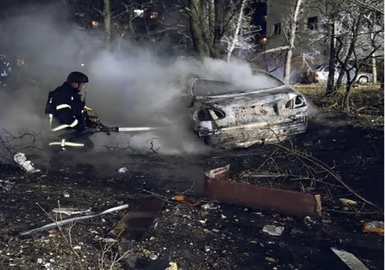
24 hours in Ukraine: A single day shows reality of life as war hits 1,000 days
Associated Press Kyiv: The clock on her wall stopped almost as soon as the day began, its hands frozen by the Russian bomb that hit the dormitory serving as home for Ukrainians displaced by war. It was 1:45 am in an upstairs room in the eastern city of Zaporizhzhia, Natalia Panasenko's home for just shy of a year after the town she thinks of as her real home came under Russian occupation. The explosion blasted a door on top of her, smashed her refrigerator and television and shredded the flowers she'd just received for her 63rd birthday. “The house was full of people and flowers. People were congratulating me... and then there was nothing. Everything was mixed in the rubble,” she said. “I come from a place where the war is going on every day. We only just left there, and it seemed to be quieter here. And the war caught up with us again.” November 11 was a typical day of violence and resilience in Ukraine.
The Associated Press fanned out across Ukraine to chronicle 24 hours of life just as the country prepared to mark a grim milestone Tuesday: 1,000 days since Russia's full-scale invasion on Feb 24, 2022. The day opened with two Russian bombings -- one that hit Panasenko's apartment and another that killed six in Mykolaiv, including a woman and her three children. Before the day was even halfway done, a Russian ballistic missile shattered yet another apartment building, this time in the city of Kryvyi Rih. Swimmers braved the Black Sea waters off Odesa, steelworkers kept the economy limping along, a baby was born. Soldiers died and were buried. The lucky ones found a measure of healing for their missing limbs and broken faces. About a fifth of Ukraine's internationally recognised territory is now controlled by Russia. Those invisible geographical lines shift constantly, and the closer a person is to them the more dangerous life is. In the no-man's-land between Russian and Ukrainian forces, there's hardly any life at all. It's called the Gray Zone for good reason. Ashen homes, charred trees and blackened pits left by shells exploding over 1,000 days of war stretch as far as the eye can see.
Odesa, 6:50 am; The waters of the Black Sea hover around 13 degrees Celsius (55 Fahrenheit) in late fall. The coastline is mined. Dmytro's city is regularly targeted by drones and missiles. But Dmytro - who insisted on being identified only by his first name because he was worried for the safety of his family - was undaunted as he plunged into the waves with a handful of friends for their regular swim. Before the war, the group numbered a couple of dozen.
Many fled the country. Men were mobilised to fight. Some returned with disabilities that keep them out of the water. His 33-year-old stepson is missing in action after a battle in the Donetsk region. For Dmytro and fellow swimmers, the ritual grounds them and makes the grimness of war more bearable. He said the risks of his hobby are well worth the reward: “If you're afraid of wolves, don't go into the forest.”
Zaporizhzhia, noon; Managing the Zaporizhstal steel mill during wartime means days filled with calculations for Serhii Saphonov. The staff of 420 is less than half its pre-war levels. Power cuts from Russian attacks on electricity infrastructure require an “algorithm of actions” to maintain operations. Russian forces are closing in on the coke mine in Pokrovsk that supplies the plant with coal. And the city is under increasing attack by Russia's unstoppable glide bombs. Right outside his office, a bulletin board displays the names of 92 former steelworkers who have joined the army. Below are photos of the dead. Staff hold fundraisers for supplies for colleagues on the front, including two bulletproof vests sitting in the corner near his desk.
Chernihiv, 1 pm Dr Vlady slava Friz has performed more reconstructive surgeries in the past 1,000 days than she did in the previous decade of her career. And the injuries are like nothing she had ever seen before. Her days start early and end late. In the first months of the war, she said, the hospital was admitting 60 people per hour, and eight surgeons worked nonstop. They're still catching up, because so many of the injured need multiple surgeries. On November 11, she was rebuilding the cheek and jaw of a patient injured in a mine explosion. “The global community continues to lose interest in the events in Ukraine while we lose people every day,” she said. “The world seems to have forgotten about us.”
 English daily published in Bengaluru & Doha
English daily published in Bengaluru & Doha





